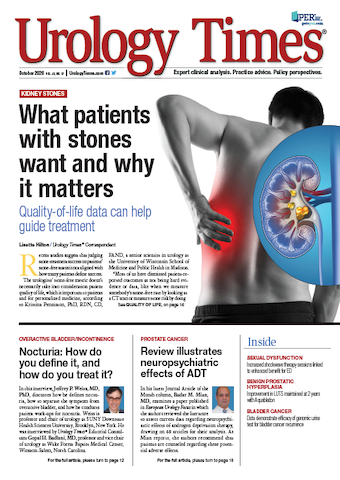Publication
Article
Urology Times Journal
How to bill for remote uroflow
Author(s):
Are there billable services related to a home uroflow? "The answer is yes, to a point and if done appropriately," write Jonathan Rubenstein, MD, and Mark Painter.
How do you bill for remote uroflow?
Jonathan Rubenstein, MD

Recently, a number of companies have come out with an option for patients to perform uroflow at home, whether by a smartphone app or using a stand-alone device. The stand-alone device at times can be owned by the practice. The question asked is whether there are billable services around the performance of a home uroflow. The answer is yes, to a point and if done appropriately. However to understand what is and is not billable, we need to break down the components of a uroflow, the currently available CPT codes, expenses incurred by a practice and the work performed by a physician.
Uroflowmetry is coded using CPT code 51741 (Complex uroflowmetry [eg, calibrated electronic equipment]). Uroflow is traditionally performed in a physician’s office at the time of an office visit. The equipment itself is usually owned or leased by the practice.
Mark Painter

This CPT code has both a technical (for owning/upkeep of equipment) and professional (interpretation) component. If a uroflow is performed in the office setting using physician-owned (or leased) equipment, CPT code 51741 is billed without a modifier. However, if a uroflow is performed in the patient’s home and not using the practice’s uroflow machine, only the professional (interpretation) component can be billed. Therefore, modifier –26 should be appended to the code to communicate the request for reimbursement for the work of the interpretation of the uroflow (only). Data obtained by the patient in their home can be transmitted to the provider for interpretation, or brought in and interpreted at the time of the office visit (assuming the process adheres to HIPAA rules). As the physician performs the interpretation in the office, the appropriate place of service is Office (Place of Service 11).
If the physician owns or leases the equipment that the patient uses for a home uroflow, there is some debate as to how best to address the technical component. Under these circumstances, the practice is paying for the device and its maintenance between patient use; however, the practice is not providing a typical general supervision of the technical collection of data as compared with the in-office uroflow test. We would interpret the place of service for the technical component for a home uroflow test as Home (Place of Service 12). The professional component is typically provided in the Office setting (11).
Medicare has assigned a different status to the supervision of the technical component (–TC). As the “–TC” requires “direct supervision of a physician” or under incident to guidelines in the office setting, reporting 51741-TC would indicate that the physician was either present during the performance of the service or using video and audio technology to supervise the uroflow test. Therefore, we do not feel it is appropriate to report the 51741-TC with place of service Home (12) for home uroflow tests unless they were supervised. The debate surrounding the reporting of code 51741 if the office supplies the equipment concerns the supervision rules of the global code or 51741 without a modifier. 51741 without a modifier or with a –26 modifier is covered under general supervision, which does not require physician presence during the performance of the test. Therefore, reporting with either place of service (Place of Service 11 or 12) would not require the direct presence of the physician.
Additionally, payers have instructed physicians to report the technical and professional services provided by the same office under the global code (no modifier) based on the date of technical services, regardless of whether they provide the professional and technical services on the same date.
Although we can agree there is some gray area with these new types of services, it is our opinion, based on Medicare intent, that reporting the technical component even when the equipment is owned or leased by the practice should not be done for home uroflow tests either under the global (51741 with no modifier) or the –TC (51741-TC). Medicare rules specify an MUE (Medically Unlikely Edit) of 1 for the 51741 and will only allow for 1 test per date. If the test is being performed at home and results transmitted to the physician’s office, only one 51741 can be submitted per date of service regardless of whether it is submitted as global (no modifier), professional (26), or technical (–TC). If multiple uroflow interpretations are provided on separate dates the service can be reported once per date the tests are interpreted.
As is typically the case, the overarching criteria for billing is medical necessity. If a physician determines based on relevant clinical data that the home uroflow test is equivalent to the office-based procedure as a diagnostic test, they can order it. The payers will also have an opinion based on current literature; therefore, a practice wishing to use the technology should check with payer coverage for each technology. The frequency or number of uroflow tests is also being studied. Currently, we do not find a frequency limitation for uroflow tests outside of the 1-per-day limitation; thus, payment for multiple uroflows provided on different dates is allowed by many payers. Again, we point to medical necessity with regard to the frequency of tests. We have heard from several urologists and have read studies that support the use of home uroflow and multiple uroflow tests for improved diagnosis and are refraining from comment in regard to actual medical necessity, as is our tradition; our comments here are intended to focus solely on billing concerns.
If the results are interpreted at the time of a follow-up office visit, billing can be done at that time. It is important to remember that the 2021 E/M guidelines clearly state that the interpretation of data separately reported (or separately paid) cannot be counted toward the “data” section of medical decision-making.
There are other codes that one can consider billing for remote interpretation of uroflow and patient management without the patient coming in for a follow-up office visit, including the following:
• CPT code 99091 (Collection and interpretation of physiologic data [eg, ECG, blood pressure, glucose monitoring] digitally stored and/or transmitted by the patient and/or caregiver to the physician or other qualified health care professional, qualified by education, training, licensure/regulation [when applicable], requiring a minimum of 30 minutes of time, each 30 days)
CPT code 99091 can be used if a physician or other qualified health care professional collects and interprets physiologic data, such as blood pressure, which is stored digitally and may be transmitted by the patient and/or the caregiver to the provider. To bill this code, the provider should create a report that describes the time it took to acquire the physiologic data, review and interpret the data, and modify any care plan as a result of the additional data acquisition. The provider must spend a minimum of 30 minutes every 30 days in the collection and interpretation of data to report this service. Work involves the physician spending more than 30 minutes during a 30-day period for the review, interpretation, and report based on the physiologic data and diary. The intraservice period may also involve communication (eg, phone calls or emails) with the patient to provide medical management and monitoring recommendations related to data collection and interpretation. Postservice work includes associated chart documentation. “Incident to” services provided by staff and conforming to Medicare guidelines may also be included to assist in the collection and interpretation of data.
Therefore, to use this code, the documentation must indicate that services longer than 30 minutes within a 30-day period were spent assisting in the collection and interpretation of a series of home uroflows and developing a report. If this code is used, physicians cannot also bill for the individual uroflows themselves, because that would be akin to being paid twice for the performance of 1 service, and you cannot bill for items or services that are separately reportable.
• CPT code 99457 (Remote physiologic monitoring treatment management services, 20 minutes or more of clinical staff/physician/other qualified health care professional time in a calendar month requiring interactive communication with the patient/caregiver during the month; first 20 minutes)
CPT code 99457 requires 20 minutes or more of clinician time or incident to staff time per calendar month. Based on interpreted data, the physician or other qualified health care professional uses medical decision-making to assess the patient’s clinical stability, communicates the results to the patient, and oversees the management and/or coordination of services as needed, for all medical conditions. The device used must be a medical device as defined by the FDA, and the service must be ordered by a physician or other qualified health care professional. Providers are instructed not to report services of less than 20 minutes, and to report 99457 only 1 time regardless of the number of physiologic monitoring modalities they perform in a given calendar month.
Note that this CPT code was actually created for cardiology, with the assumption of continuous (24 hours per day, every day) monitoring; therefore, the noncontinuous nature of intermittent uroflow testing may not qualify for the use of this code.
Providers can report encounters in which treatment or diagnostic services are provided prior to or after the analysis of a home uroflow using either remote or in-person standard E/M codes, during the PHE. They can report E/M codes in addition to codes 99091 and 51241-26, with modifiers as appropriate.
Send coding and reimbursement questions to Rubenstein and Painter c/o Urology Times®, at urology_times@mmhgroup.com.
Questions of general interest will be chosen for publication. The information in this column is designed to be authoritative, and every effort has been made to ensure its accuracy at the time it was written. However, readers are encouraged to check with their individual carrier or private payers for updates and to confirm that this information conforms to their specific rules.


















